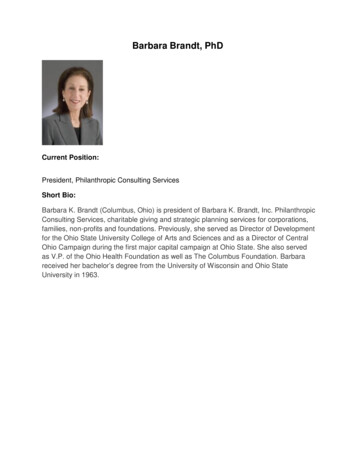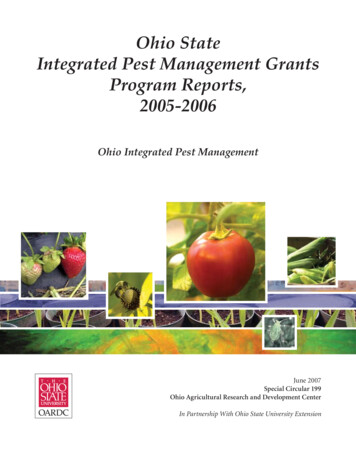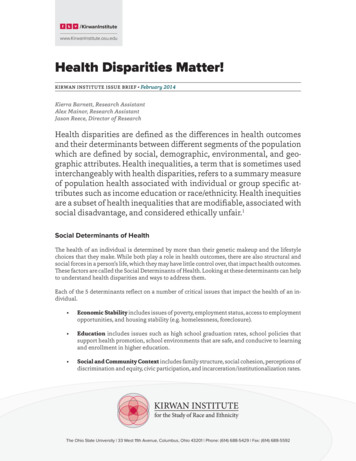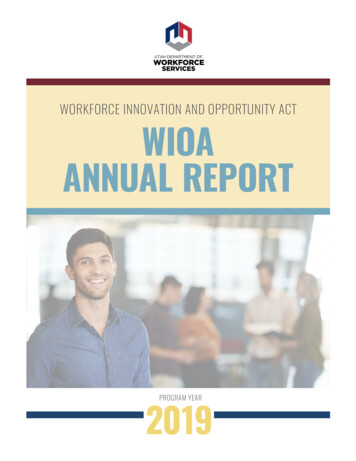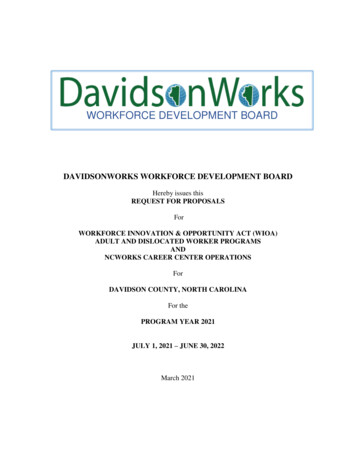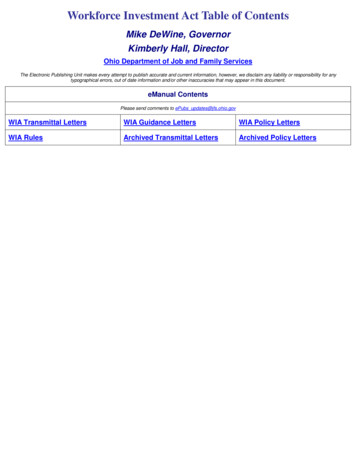
Transcription
Workforce Investment Act Table of ContentsMike DeWine, GovernorKimberly Hall, DirectorOhio Department of Job and Family ServicesThe Electronic Publishing Unit makes every attempt to publish accurate and current information, however, we disclaim any liability or responsibility for anytypographical errors, out of date information and/or other inaccuracies that may appear in this document.eManual ContentsPlease send comments to ePubs updates@jfs.ohio.govWIA Transmittal LettersWIA Guidance LettersWIA Policy LettersWIA RulesArchived Transmittal LettersArchived Policy Letters
WIA Transmittal Letters
WIATL 35 (Job Seeker Registration (Intake) in the Sharing Career Opportunitiesand Training Information (SCOTI) Labor Exchange (LE) System)Workforce Investment Act (WIA) Transmittal Letter No. 35February 1, 2008To:Local Elected Officials, WIA Local Workforce Investment Boards (WIBs), Fiscal Agents,Administrative Entities, and One-Stop OperatorsFrom:Helen E. Jones-Kelley, DirectorSubject:Job Seeker Registration (Intake) in the Sharing Career Opportunities and Training Information(SCOTI) Labor Exchange (LE) SystemI.PurposeThis communication provides guidance on job seeker registration for Wagner-Peyser Labor Exchangeservices and who can be served. Job seeker registration for Wagner-Peyser Labor Exchange servicesis accomplished through the use of the Sharing Career Opportunities and Training Information (SCOTI)Labor Exchange (LE) system.II.Effective DateImmediately.III.BackgroundThe Workforce Investment Act of 1998 transformed the Wagner-Peyser funded employment servicefrom a nationwide system of separate local employment offices into the foundation of the nation's OneStop centers. Through One-Stop centers, job seekers may receive the services they need to enter orreenter the workforce. One-Stop centers provide early intervention and referrals to suitable jobopenings, including employment services customized to job seekers' needs, such as job searchworkshops, job development, screening for referrals to jobs, referral to training, or other supportservices.IV.Guidance StatementWagner-Peyser LE services are provided to job seekers based on the customer's choice of self-serviceor staff-assisted service, to maximize customer choice in levels of services and to emphasize universalaccess. One-Stop centers provide information and resources for self-service and/or staff-assistedservices. Job seekers will be able to register for Wagner-Peyser labor exchange services in the SCOTILE system to receive LE services. The job seeker must establish an account in the SCOTI LE system.A.Eligibility - Who Can Be Served?Any job seeker in the United States may register for work, without regard to place of residence,current employment status, or occupational qualifications. Wagner-Peyser labor exchangeservices are available to citizens and nationals of the United States, lawfully admittedpermanent resident aliens, refugees, and other immigrants authorized to work in the UnitedStates. Unemployment Compensation (UC) claimants who are required to conduct work searchto receive UC must register for Wagner-Peyser labor exchange services in the SCOTI LEsystem. Registration information is self-attestation.Within the One-Stop system, there are programs that offer services to special populations suchas veterans, individuals with disabilities, migrant and seasonal farm-workers, and youth andolder workers. Inquiries should be made at the One-Stop if additional assistance is neededregarding one of these or other populations.B.Information for RegistrationContact Information
The registration process requires the job seeker to provide contact information such as anaddress and telephone number. At a minimum, the job seeker must provide an address. Contactinformation is a necessity to accomplish the labor exchange process.An exception is the case of individual who indicates his or her status as homeless. In suchinstances, the individual should be encouraged to provide a valid point of contact address suchas a family member, friend or the location of a shelter if he or she utilizes it frequently. If noother address is available, staff may list the address of the One Stop to ensure the registration iscomplete. If no address is provided, the registration will be incomplete and will not be able to bematched against possible job openings.Whenever a registered job seeker is in contact with One-Stop staff, the job seeker's contactinformation should be verified to ensure that it is current and updated in the SCOTI LE system.Social Security Number (SSN)The Wagner-Peyser labor exchange registration process requires the job seeker's socialsecurity number as an identifier. There may be situations where the job seeker refuses toprovide the social security number when using SCOTI self-service online, although SCOTI is asecure site.If a job seeker is self-registering and has no social security number or chooses not to providethe number, the job seeker is instructed to visit the nearest One-Stop center for furtherassistance. The job seeker's SSN is required to be provided during staff-assisted registration ata One-Stop center. For any job seeker who does not have a social security number, One-Stopstaff must give the job seeker a pseudo nine-digit social security number that is a temporarynumber to be used to register the job seeker. The job seeker should be instructed to contact thenearest social security office to obtain a permanent social security number. The pseudo numberwill remain in the SCOTI LE system until a job seeker provides a social security number.The formula for a pseudo number is as follows:Use 99 for the first two digits, use two digits for the month of the job seeker's birth, use twodigits for the job seeker's day of birth, use two digits for the job seeker's year of birth, and usean "0" for the last digit. If the system detects a duplicate with the pseudo number, advance thelast digit by one number until no duplicates are found.Equal Opportunity QuestionsJob seekers may decline to provide ethnicity and race information. The SCOTI system will enter"did not declare" as the default if this information is not provided and the job seeker will beallowed to register.Date of BirthRefusal to provide a date of birth will preclude the job seeker from registering. A job seeker mustbe at least 14 years of age.C.Complete and Incomplete RegistrationA job seeker's complete registration means that all required entries of the registration arecompleted and an appropriate occupational code(s) is assigned. Only registrations that arecomplete are included in job matches in SCOTI LE.At the time an individual registers for UC benefits and that individual is deemed to be a "WorkSearch Required or 'R' claimant", a complete registration is sent Real-Time to the SCOTIsystem. This 'R' claimant is active for Job Matches. At the time an individual registers for UCbenefits and that individual is deemed to be a "Work Search NOT Required or 'C' claimant", noregistration information is sent to the SCOTI system. But, upon this 'C' claimant being changedto an 'R' claimant, the INCOMPLETE registration is sent to the SCOTI system. At this time the
claimant would need to complete the registration via Self Service or visit a One-Stop tocomplete the registration to become an ACTIVE participant in Job Matches. Claimants may alsoregister in the SCOTI system by calling 1-877-OHIOJOB (1-877-644-6562) or register online atwww.scoti.ohio.gov www.scoti.ohio.gov.D.Self-Service RegistrationWith internet access, self-service registration for Wagner-Peyser labor exchange can beaccomplished in the convenience of the job seeker's home, in a public library, a One-Stopcenter, or anywhere internet access is available. The job seeker may create an account onlinefor services with the SCOTI LE system at www.scoti.ohio.gov. Once a job seeker establishes anaccount, the job seeker is registered. Information provided by the job seeker remains secureand private.E.Staff-Assisted RegistrationStaff-assisted services involve a job seeker who is registering for Wagner-Peyser LE servicesand needs assistance from staff to complete the registration process. If the job seeker desiresassistance, or is unable to complete the registration process, assistance will be provided. Thismay require an interpreter because of a hearing impairment, language difference or othercommunication barrier. Recognizing which job seekers may have difficulty with the registrationprocess is not always possible in advance. One-Stop staff should monitor the self-registrationprocess that occurs in the One-Stop center to identify job seekers who are having difficulty andarrange for assistance.Section 7(e) of the Wagner-Peyser Act requires One-Stops to provide staff-assisted LE servicesfor registering for work, job search, resume writing, job interview, exploring occupationalopportunities, obtaining information on job training or related support services. Specific LEservices that will be provided must be described in the local area One-Stop systemMemorandum of Understanding (MOU).One-Stop staff should accomplish the following:F. Review and analyze the information provided by the job seeker to ensure allqualifications for employment are adequately presented and current; Determine any needs the job seeker may have for employment counseling, selectiveplacement or other services; Give the job seeker any additional information that will increase the opportunity forplacement; Evaluate the occupationally significant facts about the job seeker and assign theappropriate O*NET Job Titles to reflect desired employment and any alternativeoccupations for which the job seeker may be qualified and/or interested; and Collect all necessary information and update the SCOTI system to maintain accuracy andto avoid duplicated efforts.Active and Inactive StatusA job seeker's registration stays active for 90 days without activity by the job seeker. After 90days of inactivity, the registration will be automatically changed by the SCOTI LE system to aninactive status. Inactive status means the job seeker will no longer be included in a match. TheSCOTI LE system generates a letter to the job seeker prior to deactivation informing the jobseeker that he or she will need to contact the One-Stop center if he or she wishes to remain inactive status to receive Wagner-Peyser labor exchange services. One-Stop staff assigned toperform LE functions can update the inactive status to active for a job seeker.V.Technical Assistance
Sharing Career Opportunities and Training Information Labor Exchange (SCOTI LE) System TrainingsessionsSCOTI Help Desk - Tel. # 1-888-2WORK-411, option 2For additional information, you may send your questions to the Bureau of Employer sWorkforce Investment Act of 1998, Public Law 105-220; WIA Final Rules, 20 CFR, Chapter V, Part652.3
WIATL 34 (Delete Exit Procedures in Sharing Career Opportunities and TrainingInformation (SCOTI))Workforce Investment Act (WIA) Transmittal Letter No. 34November 29, 2007To:Local Elected Officials, WIA Local Workforce Investment Boards (WIBs), Fiscal Agents,Administrative Entities, and One-Stop OperatorsFrom:Helen E. Jones-Kelley, DirectorSubject:Delete Exit Procedures in Sharing Career Opportunities and Training Information (SCOTI)I.PurposeThis guidance is to ensure the integrity of Workforce Investment Act (WIA) and Labor Exchange (LE)performance data and to provide parameters on the appropriate reasons and procedures to delete aparticipant's exit in SCOTI in order to maintain accuracy in reporting.II.Effective DateImmediately.III.BackgroundUSDOL Training and Employment Guidance Letter 17-05 defines program exit when a participant hasnot received a service funded by the program or funded by a partner program for 90 consecutivecalendar days, and is not scheduled for future services.An exit occurs when a WIA or LE participant does not receive services for 90 days or longer. In SCOTI,the system will automatically exit those individuals 90 days after the actual end date of the most recentservice. Occasionally, circumstances arise when an individual is exited from the system that should notbe. In this case, the exit needs to be removed as the individual is still participating in a WIA or LEprogram. Removing a participant's exit is accomplished by clicking the "unexit" button on the exit tab ofthe services screen in SCOTI.IV.Guidance StatementThe exit date is the participant's last date of service and automatically occurs 90 days from when thecase is closed. Each workforce investment area should develop processes and procedures to delete aparticipant's exit when needed. Thorough caseload management is critical to ensure participant data iscorrectly entered into SCOTI and services provided match the participant's Individual Employment Plan(IEP). Internal quality reviews should be conducted regularly and randomly as a monitoring tool tomaintain program and caseload management efficiency. Quality service to customers and accuracy forreporting to USDOL must be the top priority in making such decisions.The ability to delete exits will be given to those serving in the local Management Information Systems(MIS) field support role for WIA and to ODJFS Labor Exchange staff for LE. The delete exit feature isnot being added to enable local areas to inappropriately manipulate performance outcomes. Thisfunction will be monitored to determine if exits are being deleted other than for the reasons listedbelow.Reasons for Deleting Exits:Reasons to delete exits are decided locally. Some acceptable examples of reasons to delete exits arelisted below, but are not limited to: Incorrect actual end dates entered into SCOTI Closed accidentally Incorrect exit reason
Delete Exit ProcessThe process to delete an exit should be executed immediately when the need is apparent to: Preserve the integrity of the data Comply with data validation standards for accuracy Convey full and accurate information to USDOL when reporting performance dataAbsent extenuating circumstances, a participant's exit must be deleted within seven months (twoquarters and thirty days) of the end of the quarter in which the participant exited. The following are twoexamples of the timeframes below:Example 1Participants with exit dates of January 1 through March 31 can only be deleted through October 30.Quarter 1JanFebQuarter 2MarQuarter 1 Exit DateAprMayQuarter 3JunJulAugQuarter ------------------ OctNovDecLastdate todeleteOct 30Example 2Participants with exit dates of July 1 through Sept 30 can only be deleted through April 30.Quarter 3JulAugQuarter 4SeptQuarter 3 Exit DateOctNovQuarter 1DecJanFebQuarter ---------------- AprMayJunLastdate todeleteApril30Deleting Exits Beyond the LimitationIf an exit must be deleted beyond the above time limitations, the request must be submitted to theSCOTI help desk via email from one of the following at the local office: WIA Administrator, WIASupervisor, LE Staff, One-Stop Manager, One-Stop Supervisor, One-Stop Operator or LocalOperations Personnel. The request may also be submitted by fax to the SCOTI helpdesk, signed bythe WIA Administrator, WIA Supervisor or the One-Stop Operator. The request should includeinformation regarding the participant and the circumstance surrounding the reason to delete the exit.The request should include: Date Participant name Last four digits of the SSN Workforce area County name
Existing exit date Reason to delete exit in detail Power user's name One-Stop Operator, WIA Administrator's or Supervisor's signatureRequests will be reviewed on a case by case basis, approved or denied with discretion based on thejustification provided in the request to delete the exit. The power user will be notified when their requestis received and pending. Approvals or denials will be sent to the power user via email.V.Technical AssistanceFor additional information, you may send your questions to the Bureau of Support Services:SCOTI-HELP-DESK@odjfs.state.oh.us.SCOTI Help Desk - Tel. # 1-888-2WORK411, option 2VI.ReferencesWIA Rule 5101:9-30-04 (A) (B)USDOL, Training and Employment Guidance Letter 17-05, February 17, 2006Workforce Investment Act of 1998, Public Law 105-220WIA Final Rules, 20 CFR, Chapter V, Part 652.3Rescissions: None
WIATL 30 (Guidelines Regarding Job Orders and Employer Services)Workforce Investment Act (WIA) Transmittal Letter No. 30May 7, 2007To:Local Elected Officials, WIA Local Workforce Investment Boards (WIBs), Fiscal Agents,Administrative Entities, and One-Stop OperatorsFrom:Helen E. Jones-Kelley, DirectorSubject:Guidelines Regarding Job Orders and Employer ServicesI.PurposeTo provide guidelines to local areas for accepting job orders; to define the conditions under which joborders or services to employers can be refused; and to address policies regarding quality control of joborders.II.Effective Date:Immediately.III.BackgroundSection 7(a)(2) of the Wagner-Peyser Act, as amended by the Workforce Investment Act of 1998,Public Law 105-220, dated August 7, 1998, authorizes appropriate recruitment services and specialtechnical services for employers.IV.Guidance StatementOne-Stop staff should adhere to a uniform method of determining when job orders should be taken orrefused, what constitutes a bona fide job order, and what quality control standards should be set forwriting job orders.A.Types of Job Orders and Appropriate ActionsAlthough the principle of universal access applies to the provision of services to employers, there are anumber of circumstances in which a One-Stop center is required by law, regulation, or policy to refusea job order. The following information describes specific circumstances surrounding job orders, andwhat actions should be taken if necessary.1.Fee for Placementa.A fee for placement is a charge that consists of direct payment in exchange for thejob opening being filled. If an employer or an agency recruiting for an employer wishes toplace a job order that would charge the applicant a fee for placement, the One-Stopcenter should not take the order. The employer or agency should be informed why theorder is being refused.b.The purchase of materials, equipment, and uniforms or payment for testing andlicensing by an applicant are not considered fees for placement. If the employer requiresthat the applicant pay for such items, the job order may be taken as long as the requiredexpenses are listed on the order.c.The Wagner-Peyser Act does not prohibit the referral of an applicant to a privateemployment agency as long as the applicant is not charged a fee.2.Employer-Employee Relationshipsa.When an employer-employee relationship does not exist, an order can be refused.Typically an employer-employee relationship does not exist if the worker is anindependent contractor, and/or if the employer does not pay UnemploymentCompensation (UC) taxes or provide Workers' Compensation on behalf of the worker.
The determination as to whether a job opening will be an employee or an independentcontractor can be complex but is essentially made by examining the right to control how,when, and where the person performs services.There are three basic areas that determine employment status: behavioral control financial control relationship of the partiesMany sources are available for determining employer/employee relationships. For moreinformation, refer to: IRS 20-factor test Internal Revenue Service (IRS) Chapter 2 of Publication 15, Circular E, Employer's Tax Guide and Chapter 2 of Publication 15-A, Employer's Supplemental Tax Guideb.In the case where the worker is paid straight commission, it is normally not anemployer-employee relationship. The employer normally has to guarantee at leastminimum wage to an employee in order for an employer-employee relationship to beestablished. One-Stop centers have discretion to either accept or refuse job orders forcommission-only positions, or require the employer to use the SCOTI Bulletin Board topost such openings. (Examples would be commission-only sales, real estate agents, cabdrivers, and newspaper delivery persons.)3.Bona Fide Job Ordersa.A bona fide job order means that a current and valid job opening exists prior to anyreferrals being made, and that the One-Stop center has reasonable basis for concludingthat the employer is a legitimate employer.b.Job orders that are received to build a list of applicants for future openings are notbona fide orders and should be refused.c.One-Stop centers should be alert to the possibility that a job opening or anemployer may not be bona fide. Examples of questionable situations may be:1)When an employer requires any unusual pre-employment action on the partof the applicant such as a deposit for some alleged service (e.g., transportation,dues, food, or lodging); or2)When an unknown employer indicates that applicants will be interviewed atan address that is not a normal place of business such as a hotel room.d.Before a job order can be posted in the SCOTI system, the employer must provideits UC Tax number or Federal Employer Identification Number (FEIN). The only exceptionto this requirement is for domestic job orders where the person seeking a temporaryworker is a homeowner, not a bona fide employer. In the case of a business seeking aworker for a very short period of time (1-3 days duration), the job opening should be listedas a casual labor job order, and the employer will be required to provide either a UC Taxnumber or FEIN. If the One-Stop center cannot verify that the opening or employer isbona fide, the job order may be refused.4.Pre-designation of Applicantsa.When an employer requests that certain workers be referred on any basis otherthan an occupational qualification, the job order should be refused. For example, an
employer might identify a specific individual to be referred and indicate that he or she isnot willing to consider other applicants. Such requests for referrals are considered predesignation of applicants and make a job order unacceptable. However, an order may betaken if the employer requests that a specific person be referred and is also willing toconsider other referrals.b.An exception to the rule on pre-designation occurs when an employer lists anagricultural job order. In this instance, the employer may request a specific crew leader orworker, and the job order should be accepted.5.Discriminationa.Title VII of the Civil Rights Act of 1964, 42 USC § 2000d et seq., prohibitsdiscrimination in hiring, promotion, discharge, pay, fringe benefits, and other aspects ofemployment, on the basis of race, color, religion, sex, or national origin.b.Title VI of the Civil Rights Act of 1964, 42 USC § 2000d et seq., prohibitsdiscrimination on the basis of race, color, and national origin in programs and activitiesreceiving federal financial assistance, which would include most workforce developmentprograms and services administered by ODJFS. See also WIA Section 188.c.The Age Discrimination in Employment Act of 1967 prohibits arbitrary agediscrimination in employment against individuals 40 years of age or older by: 1) privateemployers having 20 or more employees and engaging in an industry affecting interstatecommerce, or 2) any governmental entity.d.Title 1 of the Americans with Disabilities Act (ADA) prohibits employmentdiscrimination against qualified individuals with disabilities.e.Section 504 of the Rehabilitation Act of 1973 prohibits discrimination againstqualified disabled applicants in federally-funded programs and services, including WIAand One-Stop services. See also WIA, Section 188.f.The Civil Rights Act of 1964 and the Wagner-Peyser Act require that the laborexchange system ensures that discriminatory job orders are not accepted. In addition, theCivil Rights Act of 1964 prohibits the labor exchange system from providing any serviceto an employer when there are reasonable grounds (i.e. documented evidence) to believethat the employer is engaged in discriminatory practices.g.An exception to the nondiscrimination laws is a situation involving a Bona FideOccupational Qualification (BFOQ). BFOQ pertains to an employment decision orrequest relating to age, sex, national origin, or religion is based on a finding that such acharacteristic is necessary to the individual's ability to perform the job in question.Examples of BFOQs would be a request for an actress to portray a female role in a playor movie, or a male attendant to serve in a men's locker room. Certain jobs have bonafide age requirements based on agility (e.g. fire fighter or police officer), legalrequirements (e.g. bartender), or insurance requirements (e.g. commercial drivers).Orders with acceptable BFOQs may be written and serviced. See 42 USC 2000.h.Should an employer wish to list an opening containing discriminatoryspecifications, and a BFOQ does not exist, the One-Stop center should attempt topersuade the employer to eliminate those discriminatory specifications. If the employer iswilling to change his or her requirements, the order may be accepted. Otherwise, theorder must be refused.6.Affirmative Actiona.An affirmative action job order is one that seeks qualified applicants, particularlymembers of a specified group that, for non-occupationally valid purposes, have been
discouraged from entering certain occupational fields. In addition, it is an order thatresults from:1)Executive Order No. 11246 and implementing instructions at 41 CFRChapter 60, requiring certain government contractors to take affirmative action tohire and promote qualified minorities and women; or2)Section 503 of the Rehabilitation Act of 1973 and implementing regulationsat 41 CFR Part 60-741 requiring certain government contractors to take affirmativeaction to employ and advance in employment qualified disabled workers; or3)Section 402 of the Vietnam Era Veterans Readjustment Assistance Act of1974 and implementing regulations at 41 CFR part 60-250 requiring certaingovernment contractors to take affirmative action to employ and advance inemployment Vietnam-Era and disabled veterans; or4)A court order resulting from a decision in which there was a finding ofemployment discrimination; or5)A conciliation agreement as authorized by Title VII of the Civil Rights Act; or6)Provisions of federal, state, or local fair employment practice law; or7)An affirmative action plan adopted pursuant to the Equal EmploymentOpportunity Commission's guidelines on Affirmative Action (29 CFR Part 1608).b.One-Stop centers should accept all legitimate affirmative action job orders andmay assist the employer with special applicant searches and recruitment efforts.However, applicant file searches must follow the standard job order processingprocedures including veteran preference requirements. For example, if an employerplaces a job order, indicates that it is an affirmative action order and desires recruitmentbe done for minorities, the One-Stop center should make every effort to ensure that therequested group is represented among the qualified veterans and other applicantsreferred. Employers should be advised that an order that requires exclusive referral of aspecific applicant group, or referral of a specific applicant group "quota," cannot beserviced as long as these restrictions are held.c.An affirmative action order should be clearly marked as affirmative action andclearly reflect the employer's needs. An example of appropriate language to be includedin the job order requirements section might be: "Affirmative Action: All qualified applicantswill be considered. Minorities and women encouraged to apply."7.Violations of Lawa.Job orders that contain job duties or terms or conditions of employment that arecontrary to law should be refused. Examples of such orders would be those specifyingpay below the legal minimum wage, requiring the worker to perform illegal activities, orspecifying hours for a youth worker in violation of child labor laws.b.One-Stop centers should explain the legal basis for refusing the order to theemployer and offer the opportunity for the order to be modified. If the employer agrees toan appropriate modification, the job order may be accepted. Otherwise, the order must berefused.8.Labor Disputesa.A "labor dispute" is defined in 29 USC 152(9) as any controversy concerning theterms or conditions of employment, or any controversy concerning the association orrepresentation of individuals in negotiating, maintaining, changing, or seeking to arrangethe terms or conditions of employment.
b.When a labor dispute results in a work stoppage (such as a labor strike, walkout orlockout), One-Stop centers are restricted from accepting or servicing job orders that willdirectly, or indirectly aid in filling positions that are vacant because the former occupant ison strike or is being locked out in the course of a labor dispute, or the filling of which isotherwise an issue in the labor dispute. See 20 CFR 652.9.c.One-Stop centers may accept job orders from an employer involved in a labordispute until a work stoppage occurs, and may accept job orders during a work stoppageas long as the orders are for positions that are not impacted, either directly or indirectly,by the work stoppage.d.Should job orders for positions not impacted be taken from an employer involvedin a work stoppage, One-Stop centers are responsible for notifying any applicantsreferred that the employer is involved in a labor dispute and that the position listed on thejob order is not vacant as a result of the dispute. One-Stop centers are encouraged toinclude this information in the job description of the job order.e.Once a labor dispute resulting in a work stoppage has been resolved, the OneStop center may once again resume full service to the employer. See 20 CFR 65
Workforce Investment Act Table of Contents Mike DeWine, Governor . Kimberly Hall, Director . Ohio Department of Job and Family Services. The Electronic Publishing Unit makes every attempt t



